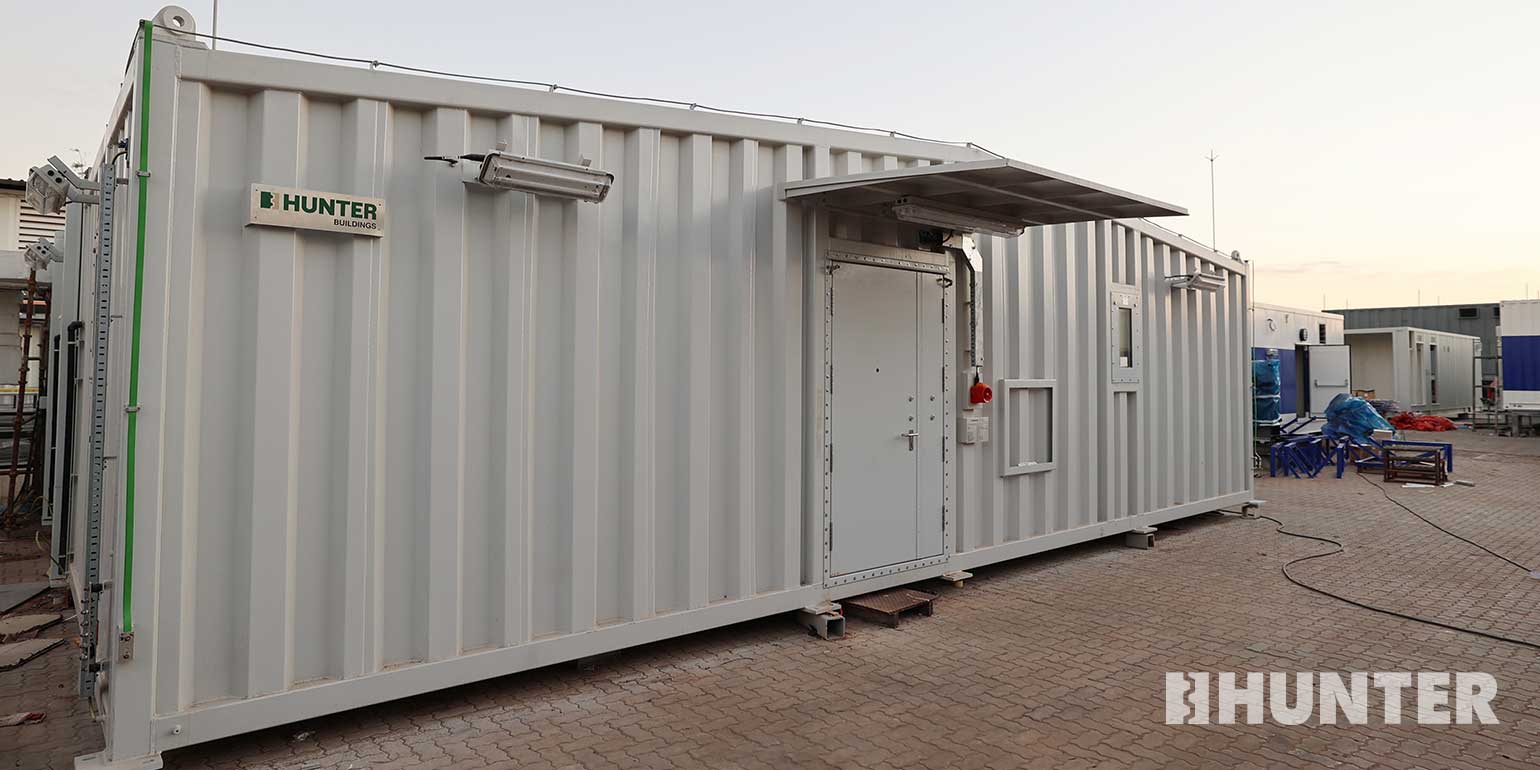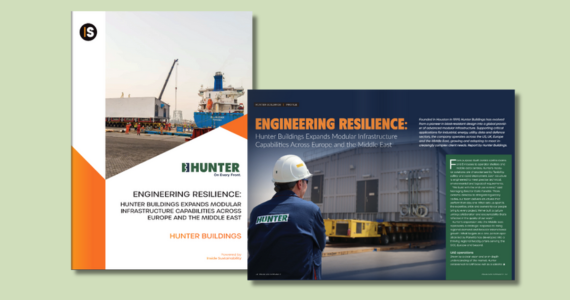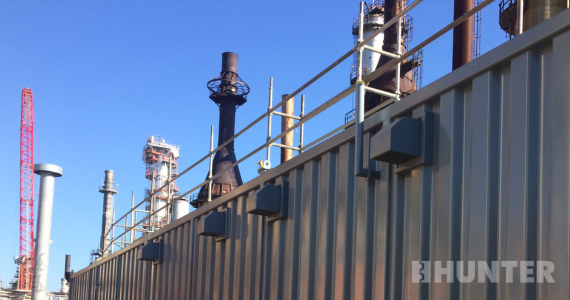Modern-day jobsites require next-level safety considerations, particularly in industries where workers are exposed to risks such as explosions and blasts. Blast-resistant buildings, designed to withstand the force of an explosion, have become indispensable in protecting lives and property. But what is a blast-resistant building? (It’s a question asked more often than you might think.)
In this blog post, Hunter’s manufacturing experts explore the details surrounding these often-misunderstood structures. Read on for insights into what a blast-resistant building is (and isn’t), the components that go into a structure designed to protect, and design and engineering considerations to ensure a finished structure serves operations’ one-of-a-kind needs.

Blast-Resistant vs. Blast-Proof Building: Understanding the Vernacular
Proper word choice is important when dealing with industrial structures, systems and equipment. In the context of the blast-resistant vs. blast-proof building, the latter term is misleading. The proper term for these buildings is “blast-resistant” because no structure is 100% blast-proof. Let’s break down the terminology.
- Blast-Resistant Building: A structure designed to minimize damage while protecting occupants, systems and equipment in the event of a blast or explosion.
- Blast-Proof Building: A structure designed to withstand a blast or explosion without sustaining any structural damage or compromise.
Hunter and other blast-resistant building manufacturers strive to create structures that protect what matters while sustaining minimal damage. And, while those structures come close to being what many might describe as being blast-proof, to describe them as such would be inaccurate and potentially dangerous.
Of course, we regularly field inquiries from companies requesting blast-proof buildings. In those instances, we work to educate potential clients about the proper terms. This not only ensures they understand what they’re purchasing and the protections those structures offer, but it streamlines and simplifies the overall project.
Crucial Components of Blast-Resistant Module (BRM) Construction
Although every BRM construction project will vary based on operational needs and customer requests, there are a number of elements that remain largely steady throughout. Here is a high-level look at the structural components and considerations necessary when producing a blast-resistant module.
- Reinforced Walls, Roofs, Cladding and Supports: Extensive reinforcement is important for structures designed for use in danger-prone environments. At Hunter, we recommend reinforced steel for optimum safety and streamlined builds, but blast tents also offer a high level of protection.
- Blast-Resistant Building Accessories: Blast doors and blast mitigation windows are two common additions to today’s industrial structures. These components are designed to withstand the initial shockwave and flying debris generated by a blast, while also protecting against concerns such as toxic gas ingress. At the same time, they help create comfortable, easily accessible work environments with improved visibility.
- Anchoring and Energy Absorption Systems: A carefully planned blast-resistant module features structural considerations that allow it to remain rooted in place, yet able to withstand the shocks and movements associated with large-scale blasts.
- Safety System Considerations: Blasts aren’t the only concerns for industrial teams. Most BRMs will incorporate additional safety measures such as fire detection, protection and suppression systems, special filtration options or gas detection systems.
- Compliance with Industry Standards: Careful testing and assessment ensure a blast-resistant building meets the design and engineering standards set forth by regulating agencies — and, more importantly, that a structure can adequately protect an operation’s people, processes and equipment. American Petroleum Institute blast standards, which we discuss in further detail below, is the guiding source for blast resistance building standards.
American Petroleum Institute (API) Ratings and Blast Resistance
American Petroleum Institute Recommended Practice (API RP) standards play a pivotal role in the construction, certification and operation of blast-resistant buildings. By providing a baseline for manufacturers to design to, API RP guidelines create consistency within the industry and help ensure completed structures offer the requisite protection.
Three API RP ratings in particular help guide design, location and engineering decisions for blast-resistant buildings. These include:
- API RP 752: Building overpressure guidance for rigid, permanent structures located at chemical and petrochemical plants, refineries, onshore facilities or natural gas plants. API RP 752 aids in risk management related to fires, explosions or the release of toxic materials.
- API RP 753: Location guidance for portable buildings which could be at risk of experiencing fires, explosions or safety hazards related to the release of toxic materials. API RP 753 indicates which types of structures are allowable in a given area based on that area’s blast zone rating.
- API RP 756: Protection standards for blast-resistant tents located at refineries, chemical and petrochemical plants and natural gas operations. API RP 756 is focused on hazard management for structures that offer uniquely portable protection.
Please Note: All Hunter buildings are API RP 752/753/756 compliant and feature blast ratings of 10 PSI (690 mbar) or custom ratings as determined by project location and needs.
Determining the Right Blast Construction Approach for Your Project
As we’ve mentioned, every blast-resistant building is as unique as the operation it serves. Careful consideration from the project’s start will help ensure your structure supports operational efficiency while providing the protection your crews and systems require. Here are some factors to consider.
- Traditional or Modular Construction: Modular blast-resistant buildings take approximately 50% less time to build — and cost about 50% less — when compared to traditional construction. They are also easily transportable, allowing them to find new life in other areas of a plant, or other locations altogether, once the projects for which they were initially built reach completion.
- Blast Rating Requirements: API RP blast rating requirements will vary based on factors such as your operations’ geographic location, proximity to industrial process areas and the types of materials handled on-site. Working with a team that understands the risks associated with such work, as well as applicable regulatory requirements, can help streamline the planning and installation processes. Hunter is well versed in all aspects of blast-resistant building manufacturing and installation.
- Steel vs. Other Building Materials: Hunter’s blast-resistant modular buildings are made of reinforced steel, a material selected for its incredible strength, protective quality, versatility and environmentally friendly benefits. Inorganic steel doesn’t fall victim to issues such as mold, moisture retention or corrosion like concrete or wood-framed buildings do, and it offers better protection against fire and blasts. Steel can also be recycled countless times without ever losing its strength.
- Design Capabilities: Protective qualities are the most important aspect of your blast-resistant building, but design elements matter, too. It’s important to source a building with adequate room for crewmembers, equipment and systems — and elements suited to unique operational needs. Modular steel buildings can be customized with options for multi-module designs, specialty flooring and even full kitchen and washroom accommodations. Unlike other building types, steel buildings also allow for large open spaces unencumbered by support columns.
- Related Project Support: Ideally, you’ll want to work with a blast-resistant building firm that can aid in other aspects of your project, too. Teaming with a company that has experience with site services, logistics and even project management eases stress on busy jobsites and streamlines builds. At Hunter, our blast-resistant building pros offer everything from initial design-build services, through engineering, construction and commissioning — and maintenance long after a build is complete.
What is a blast-resistant building? It’s the culmination of careful planning, construction and engineering efforts, all to help industrial operations take on their work in a safer, more strategic manner. And at Hunter, it’s what we do. We’re proud to say we aren’t just the industry leader; we were the first to forge the way.



